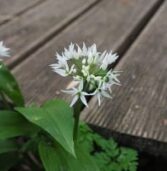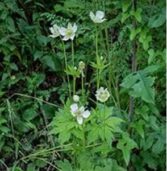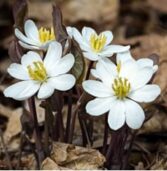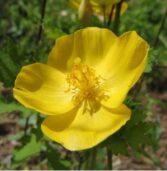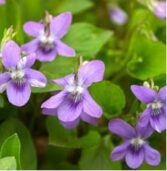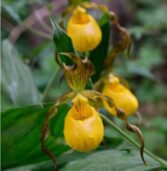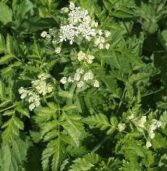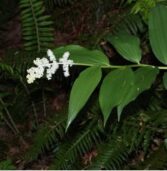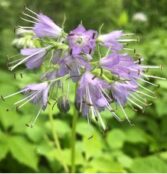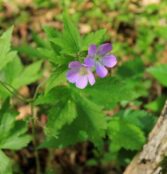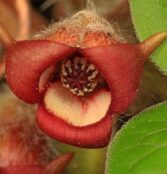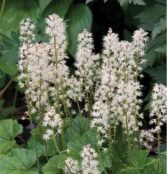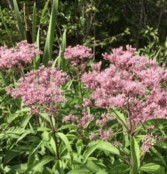Mid-Season Blooming (Spring-Summer*)
Wildflower Plants
An Identification Guide
*grouping is approximate since many bloom times overlap.
The majority of the plants growing in the Wildflower Garden were native to mid-central North America before the arrival of European settlers.
Some species are found throughout the garden, others occur naturally.
Jacob's Ladder

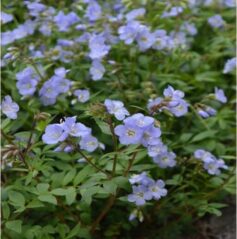
Jacob's Ladder
Polemonium reptans
- Life Cycle: Perennial
- Bloom Time: April-June
- Sun Exposure: Full, Partial, Shade
- Bloom Color: Blue
Like many spring blooming natives, the bloom time on Jacob's Ladder is short but sweet. The few short weeks in April or May that the flowers appear, the plant will be covered in blooms that range from shades of pink to blue. Jacob's Ladder will grow in full sun if it has adequate moisture, but it prefers woodlands (almost full shade) and woodland edges (partial shade.) A mature plant will only reach heights of 1' and is deer resistant.
Other common names include Bluebell, Greek Valerian, and Skunk Weed.
Wild Leek
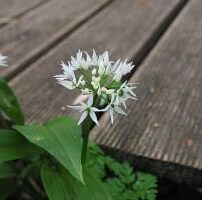
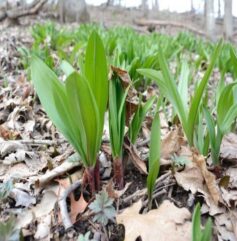
Wild Leek
Allium tricoccum
- Life Cycle: Perennial
- Bloom Time: June-July
- Sun Exposure: Partial, Shade
- Bloom Color: White
Wild Leeks are renowned for their edible bulbs and leaves that have a mild onion flavor. The foliage dies back as the flower stalk emerges. Throughout June and July, buds burst out of their papery confines and open to reveal creamy-white flowers that bloom in a bountiful, domed cluster. This species provides welcome pops of brightness in the shade garden after most ephemerals are spent. As the summer months progress, the blossoms dry and showcase pearly black seeds.
This seedhead will often persist throughout the fall and winter months. This plant prefers typical woodland conditions with dappled sunlight sustaining the Wild Leek's foliage in early spring, and deeper shade as the trees leaf out while the plant flowers.
Thimbleweed
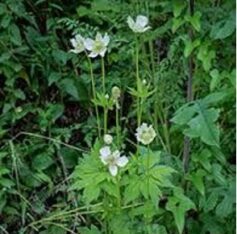
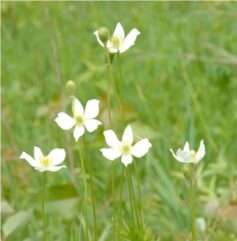
Thimbleweed
Anemone virginiana
- Life Cycle: Perennial
- Bloom Time: June-August
- Sun Exposure: Full, Partial, Shade
- Bloom Color: White
Tall Thimbleweed has long-lasting, off-white flowers, and as with the other anemones, what appear to be petals are actually colored sepals. The thimble-like seed heads are ornamental, becoming fluffy when they disperse their seed. This makes them fun multi-season plants of interest. Tall thimbleweed prefers open woods and clearings.
Before the seed head is developed, it is best to look at the leaves along the flowering stem. Anemone virginiana usually has 3 leaves at the base of the inflorescence, and a pair of leaves on each flower stem.
Wild Blue Phlox
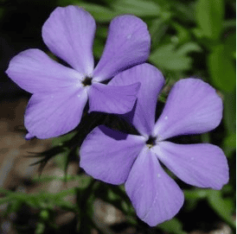

Wild Blue Phlox
Phlox divaricata
- Life Cycle: Perennial
- Bloom Time: May-June
- Sun Exposure: Partial, Shade
- Bloom Color: Blue
This is a Phlox for shade or partial shade and medium to drier soils. Wild Blue Phlox is rhizomatous and will spread slowly but steadily. It is also commonly referred to as Blue Phlox, Woodland Phlox, or Louisiana Phlox. Some may call it Wild Sweet William, but that is the common name we give to Phlox maculata. The flowers, atop sticky stems, are slightly fragrant and range in color from pale blue to lavender to violet. Deer seem to have little interest in Phlox, but rabbits especially like Wild Blue.
Twin Leaf
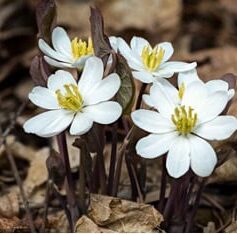
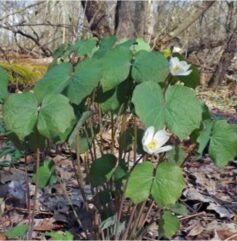
Twin Leaf
Jeffersonia diphylla
- Life Cycle: Perennial
- Bloom Time:
- Sun Exposure: Shade
- Bloom Color: White
Diphylla flowers in early spring. These single white flowers resemble Bloodroot; however, the "twin leaves" of Jeffersonia diphylla are very distinct. Its flower stalks and leaves grow directly from an underground rhizome. Twin Leaf is not considered a Spring Ephemeral because the leaves remain photosynthetically active all summer. Twin Leaf can be found in hardwood forests, where it prefers to be shaded throughout the summer.
Celandine Poppy

Celandine Poppy
Stylophorum diphyllum
- Life Cycle: Perennial
- Bloom Time: April-May
- Sun Exposure: Partial, Shade
- Bloom Color: Yellow
Also known as Wood Poppy, this attractive woodland plant will grow well in zones 4-8 in with little to no care in rich woodland soils. It can tolerate drier, sunnier sites with some care. A welcome, well-deserved sight in April after a long winter. After seeds drop out of its large, hairy pods, Celandine Poppy will mostly disappear as taller, summer shade plants surround it. Seedlings will emerge in distant areas from the mother plant as it is thought that ants aid in seed dispersal.
Common Violet

Common Violet
Viola sororia f. rubra
- Life Cycle: Perennial
- Bloom Time: April-June
- Sun Exposure: Full, Partial, Shade
- Bloom Color: Blue, Bi-color blue-white
Common violet is a stemless, herbaceous, perennial wildflower that is well known for its heart-shaped foliage, blue-violet flowers in spring and summer, and ability to rapidly spread in clumps throughout the landscape. It does well in many tough growing situations and pops up nearly everywhere in the Midwest.
Downy Yellow Violet
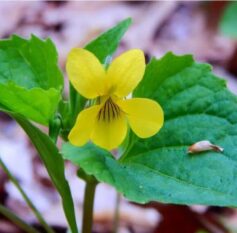
Downy Yellow Violet
Viola pubescenc
- Life Cycle: Perennial
- Bloom Time: May-June
- Sun Exposure: Full, Shade
- Bloom Color: Yellow
Downy Violet is a clump-forming perennial boasting bright yellow flowers with tiny black whiskers painted toward the throat. Blooming late spring and early summer. The blossoms are borne solitary on short, leafy stems and rise above sturdy foliage of heart-shaped, toothed leaves. Both stems and leaves are softly hairy, hence the common name.
Downy violet remains green throughout the summer if there is enough moisture, otherwise it goes dormant.
Yellow Lady's Slipper
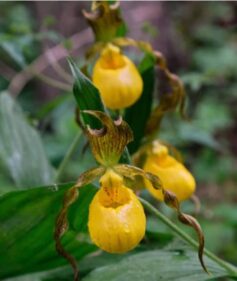
Yellow Lady's Slipper
Cypripedium parviflorum var. pubescens
- Life Cycle: Perennial monocot
- Bloom Time: May-June
- Sun Exposure: Partial, Shade
- Bloom Color: Yellow
The large yellow lady’s-slipper is a stately wildflower, native to Iowa, that grows in a number of habitats—in moist and mesic woods, on hillsides, and bogs. But because orchids have highly specific requirements for germination, growth, and reproduction ( up to 16 years to bloom), the conversion of natural lands for agricultural development has resulted in such loss of habitat that all but a handful of orchid species are now considered threatened or endangered.
Sweet Cicely
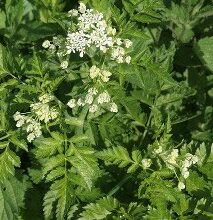
Sweet Cicely
Osmorhiza claytonii
- Life Cycle: Perennial
- Bloom Time: May-June
- Sun Exposure: Shade
- Bloom Color: White
Sweet Cicely is a perennial that is part of the carrot family. It grows in the wild in mesic forests and on wooded slopes. The white flowers of this plant can be found at the top clustered into four to seven flowers each. The leaves resemble ferns; dark green leaves are compounded in threes one or two times and have serrated edges. All surfaces of Sweet Cicely are hairy, especially on veins on the underside of the leaves. Towards the end of the season dry brown seeds appear that split into two when ripe.The roots, when dug, are said to give off an anise-like flavor.
False Solomon Seal
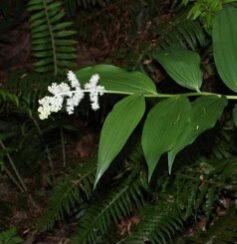
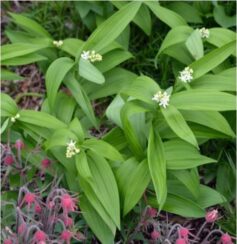
False Solomon Seal
Maianthemum stellatum
- Life Cycle: Perennial
- Bloom Time: April-June
- Sun Exposure: Full, Partial, Shade
- Bloom Color: White
Starry Solomon's Plume is very easy to grow. It is rhizomatous and spreads readily in many sun and soil situations, between 1-2' per year. Attractive leaves, flowers and green berries with maroon stripes that eventually turn bright red give the plant 3-season interest. Narrower leaves and spike-like rather than feathery white flowers differentiate it from Solomon's Plume (Maianthemum racemosa).
Other common names are Starry False Solomon's Seal and Starry False Lily of the Valley.
Virginia Waterleaf
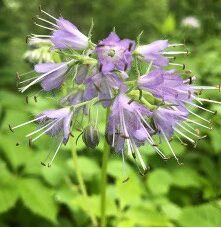
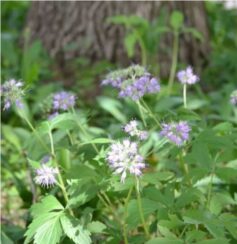
Virginia Waterleaf
Hydrophyllum virginianum
- Life Cycle: Perennial
- Bloom Time: May-June
- Sun Exposure: Partial, Shade
- Bloom Color: Purple
The name Hydrophyllum means 'water leaf.' Notice how the early season leaves of the Virginia Waterleaf appear to have water droplets. Virginia Waterleaf's small, light purple, bell-shaped flowers bloom from May to June. These small flowers attract mainly bees, but also some other pollinators. Virginia Waterleaf is a classic Northwoods plant. It prefers partial sun to full shade and medium soils. In its native range, you can find Virginia Waterleaf in wooded areas, specifically deciduous woodlands.
Wild Geranium
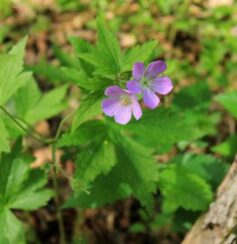
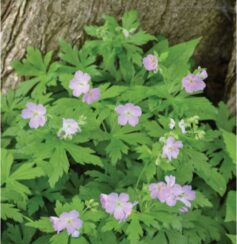
Wild Geranium
Geranium maculatum
- Life Cycle: Perennial
- Bloom Time: April-July
- Sun Exposure: Full, Partial, Shade
- Bloom Color: Purple
Wild Geranium is native to much of eastern North America, it never disappoints. It has lovely dissected leaves, beautiful pinkish-purple flowers, and it readily spreads, forming stunning patches that everything from bees to butterflies can't resist. Interestingly, Geranium maculatum has a unique way of spreading its seeds. Each seed is packed into a pod and the pods are attached to a structure that resembles a crane's bill. As the bill dries, it literally catapults the seeds away from the parent plant. Each seed has a small tail-like structure attached to it that bends and moves in response to changes in humidity, which helps to drive the seed into the soil where it can safely germinate.
Wild Ginger
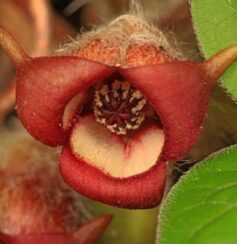
Wild Ginger
Asarum canadense
- Life Cycle: Perennial
- Bloom Time: April-June
- Sun Exposure: Shade
- Bloom Color: Red
Best known for its use as an attractive, low-growing ground cover in a shaded, or dappled light setting, Wild Ginger is also deer-resistant.
It will max out at about 6" in height and the large heart-shaped leaves can be 6" in diameter. The leaves are shiny when fully opened and the stems are hairy. Unlike many early spring woodland plants, Wild Ginger will keep its foliage throughout the season; it will not go dormant so it is a good species to plant among the spring ephemerals that do go dormant. An attractive dark red flower will appear under the plant early spring but will fade fairly quickly.
Foam Flower
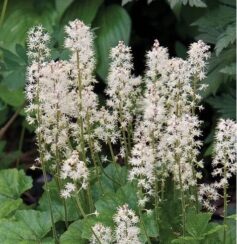
Foam Flower
Tiarella cordifolia
- Life Cycle: Perennial
- Bloom Time: May-June
- Sun Exposure: Partial, Shade
- Bloom Color: White
Foam flower is one of the showiest spring wildflowers, native to the woodlands and forests of the eastern United States. A beautiful addition to the shade garden, the starry white flower spikes are often accented with a tinge of pink. Evergreen in the southern parts of its range, the handsome lobed foliage stays attractive all summer and turns hues of red and bronze in the fall. The dense foliage hugs the ground and flower spikes rarely exceed one foot.
Sweet Joe Pye Weed
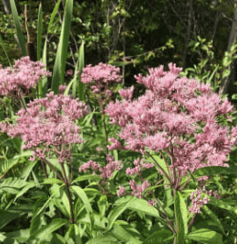
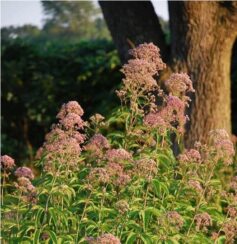
Sweet Joe Pye Weed
Eupatorium purpureum
- Life Cycle: Perennial
- Bloom Time: August-September
- Sun Exposure: Partial, Shade
- Bloom Color: Pink, Purple
Perfect for shady butterfly gardens, Eupatorium purpureum thrives in semi-shade and woodland edges, as well as in full sun. The large pink flowers are a favorite nectar source for Monarchs, Swallowtails and many other butterflies. The textured foliage looks good all summer long. "Sweet Joe" is an excellent, well-behaved garden plant with a shallow fibrous root that won't interfere with other garden perennials. A great contributor whether massed, naturalized or in the border garden.


